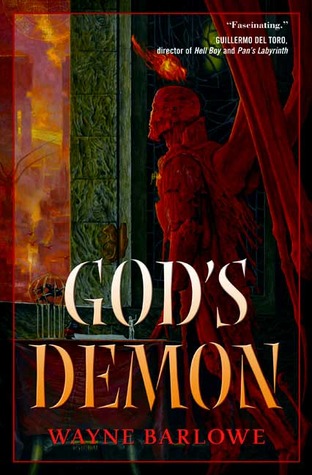 By WAYNE BARLOWE (Tor; 2007)
By WAYNE BARLOWE (Tor; 2007)
These days true ambition is a rare commodity. After wading through so many uninspired horror novels content to recycle tired narratives about middle class dweebs caught up in supernatural shenanigans, I’ve been longing for something with a bit more scope—something, perhaps, along the lines of Milton’s PARADISE LOST.
I was more than pleased, then, to discover GOD’S DEMON by Wayne Barlowe, a panoramic, multi-faceted epic set in Hell. This Hell is a minutely drawn landscape directly inspired by the aforementioned PARADISE LOST and the author’s own illustrations. Wayne Barlowe is best known as a graphic artist, in which guise he initially explored the inferno in the books BARLOWE’S INFERNO (1999) and BRUSHFIRE (2001). GOD’S DEMON is the logical outgrowth of Barlowe’s obsession with the underworld.
The inferno of GOD’S DEMON is composed of far-flung cities run by various fallen angels. (The Fall, an event referred to throughout this book, was detailed in PARADISE LOST, which you should probably read if you want to fully understand GOD’S DEMON.) Two such cities are singled out: Dis, the infernal capital built by Lucifer himself, and Adamantinarx, a more advanced metropolis run by Lord Sargatanas, who has never entirely forgotten his time in Heaven—and, as the book opens, secretly longs to go back.
Another pivotal character is Hani, a human soul condemned to Hell. Hani initially can’t remember who he was back on Earth, but does so eventually, proving quite helpful to Sargatanas. There’s also Lucifer’s consort Lilith, who develops an attraction to Sargatanas, and Beelzebub, the Lord of the Flies. The latter was Lucifer’s right hand man but now rules Hell, his master having mysteriously disappeared after the Fall.
It all leads to an all-out war—a rebellion to be exact, not unlike that which got the onetime angles booted from Heaven. Only this time the rebels are demons, led by Sargatanas, going up against their own kind, in the form of Beelzebub and his minions, in an effort to be let back into the overworld.
There’s plenty of nastiness on display, as you might guess, although those expecting torture and evisceration will likely be disappointed (there are other books to turn to for that). What Wayne Barlowe offers instead is a well-imagined dissection of the various political factions governing Hell and the unique construction and machinery that make the place run—namely human souls transformed into bricks and other objects.
Barlowe’s many larger-than-life protagonists are all well developed, three-dimensional individuals tormented by doubts and misgivings about their longed-for redemption. That’s in addition to Barlowe’s considerable descriptive powers, every bit as vivid and grandiose as I’d expect from an artist-turned-writer, yet still succinct and to-the-point.
But there’s one thing that bothers me. Not to give anything away, but a certain two personages pivotal to any account of Heaven and Hell never make an appearance outside a few scattered flashbacks. I’m assuming a sequel is in the works wherein these characters finally turn up, because their absence frankly leaves a bit of a void. Otherwise, though, this is a top-notch work that will likely resonate with religious fanatics and atheists alike, as well as those desiring a bit more in their horror literature.
